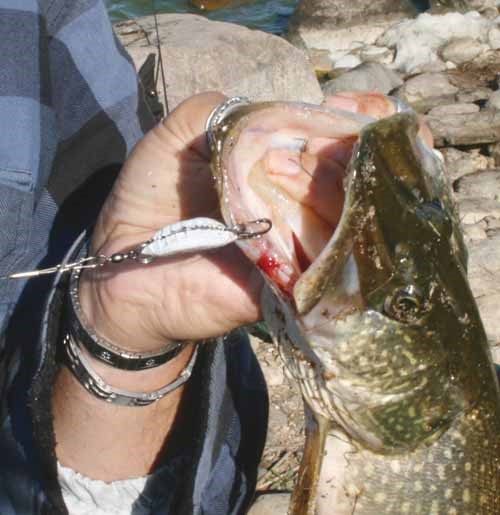This week I thought I'd provide a little information on a fishing-related project I undertook over a few days off from work.
I embarked on an attempt to make my own fish hooks.
When it comes to making hooks there are generally two main options.
One is to carve plugs out of wood, in particular poplar. That might be a winter project, but given a general lack of painting skills, and the potential to carve off a finger with a sharp knife whittling, I am not sure how far that might go.
You can make spoons too, out of, yes common stainless steel teaspoons and of course for larger hooks from tablespoons.
The handles too can be used for a variety of shapes as well.
I have collected a few spoons and will be drilling and cutting and adding hooks to see what I can come up with.
The idea of catching a pike on a spoon I have made myself intrigues me heading toward fall fishing.
Thanks to the Internet I did find a third hook option, and certainly a simple option at that.
The lures are fashioned out of beer bottle caps. You take a cap from a preferred beverage, ones with colour work best.
That is one of the neat things. Caps come in a range of colours, the painting in essence already done for you.
Once you have the caps you basically need a hammer and nail to make the holes, although a slower speed drill can help smooth the holes, and needle-nose pliers are handy as well. You will need to buy treble hooks, split rings, swivels and some fishing weights.
Use a nail to put a couple of holes into the lip of the cap just past the crimped edge. The two holes should be directly opposite each other. The holes can then be drilled just large enough for split rings to go through.
Once the rings are in, fold the cap in half. Many do this while enjoying a beverage just out of habit.
To add some weight for casting you can put split shot weights, or bee-bees inside the cap as you fold it. Smaller weights will give the hook a rattle effect. Larger weights help cast further.
Add a treble hook and you are set to go.
If you want a clear epoxy spray might add some life to the hook, but these are so easy to fashion its simpler to make a new one if the logo chips off.
So how do the bottle cap lures work?
To be honest I wasn't expecting much. I made three hooks and figured I'd get to water try them for a half hour, or so, get zippo and they would stay in the bottom drawer of my tackle box as a novelty.
That said I was eager to try them, so headed to Stony Lake south of Margo, a lake visited earlier this year.
I started the day with a Len Thompson and soon had a couple of pike. So I knew they were biting.
Out came the first bottle cap lure, a white with some red lettering. Five casts and bang a small pike. Sure I threw him back, but the homemade lure worked. That catch, in spite of being a throwback, is easily among my top five catches of the year because it was a home-crafted lure.
I switch immediately to a green cap. Four casts and another hit, this one the biggest of the day (a nice 67 centimetre pike).
Now some might point out pike are voracious feeders and hit on anything at times, but a black and yellow cap never attracted a pike. The other two hooks each caught a pair on the day.
So the bottle caps work. I may not use every trip, but I will add a few additional colours and whenever I do use and they work there will be that extra little smile knowing I made the hook.



